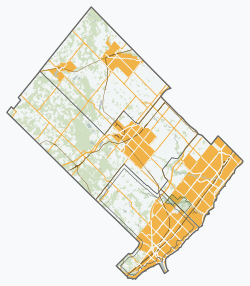Speyside | |
|---|---|
Unincorporated community | |
 Entering Speyside from the south along Highway 25 | |
| Coordinates: 43°34′41″N 79°58′34″W / 43.57806°N 79.97611°W | |
| Country | Canada |
| Province | Ontario |
| Regional municipality | Halton |
| Town | Halton Hills |
| Time zone | UTC-5 (Eastern (EST)) |
| • Summer (DST) | UTC-4 (EDT) |
| GNBC Code | FCRCB[1] |
Speyside is an unincorporated community in Halton Hills, Ontario, Canada.[1]
Once a thriving pioneer community, little remains of the original settlement.[2]
The Bruce Trail and Speyside Resource Management Area are located near the settlement.[3]
History
[edit]
Early settlers believed a local creek resembled the River Spey in Scotland, and named the new settlement "Speyside".[2]
Between the 1850s and 1870s, Speyside had a hotel (the Stewart Hotel), two general stores, a village hall (used as a school), a tannery, a blacksmith, two saw mills, and a stone quarry.[2][4] The settlement had seven streets and several houses.[2] The population in 1874 was 200.[4] Speyside had a post office from 1873 to 1914.[5]
By 1908, the population had declined to 40.[6]
An oak tree in Speyside is recognized for its historic importance. The tree was grown from an acorn of an English oak growing in Royal Park in Windsor, England. The acorns were sent across the Commonwealth to commemorate the coronation of King George VI and Queen Elizabeth. The acorn was planted at a nearby school in 1937, and then transplanted to the school in Speyside when it opened in 1960. The school closed in 1986.[7]
References
[edit]- ^ a b "Speyside". Natural Resources Canada. October 6, 2016.
- ^ a b c d Clarke, Gwen (June 2, 1955). "Speyside Looks Back to Century of Activity With Sawmills, Hotels, Hop Kilns and Quarry" (PDF). The Canadian Champian.
- ^ "Halton Hills Cultural Master Plan" (PDF). Town of Halton Hills. May 2013.
- ^ a b Crossby, Peter Alfred (1874). Lovell's Gazetteer of British North America. Lovell. p. 320.
- ^ "Speyside". Library and Archives Canada. May 27, 2014.
- ^ Lovell's Gazetteer of the Dominion of Canada (PDF). John Lovell & Son. 1908. p. 878.
- ^ Niblock, Frances (July 17, 2008). "Royal Oak at Speyside Designated Ont. Heritage" (PDF). The New Tanner.


Well, that’s interesting to know that Psilotum nudum are known as whisk ferns. Psilotum nudum is the commoner species of the two. While the P. flaccidum is a rare species and is found in the tropical islands. Both the species are usually epiphytic in habit and grow upon tree ferns. These species may also be terrestrial and grow in humus or in the crevices of the rocks.
View the detailed Guide of Psilotum nudum: Detailed Study Of Psilotum Nudum (Whisk Fern), Classification, Anatomy, Reproduction